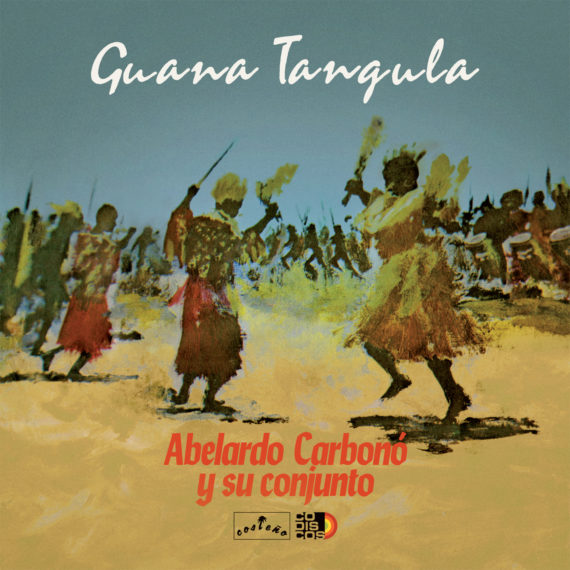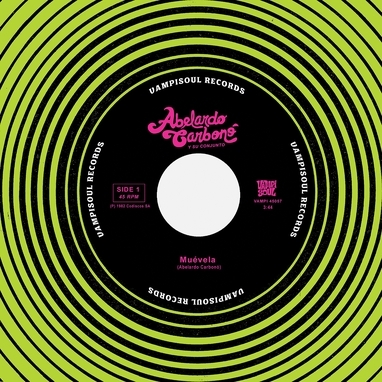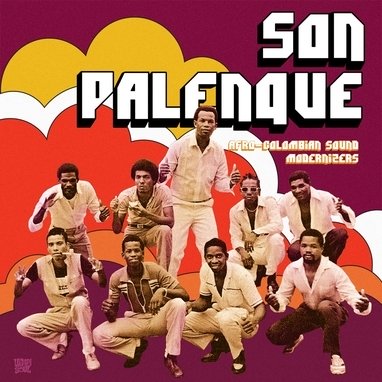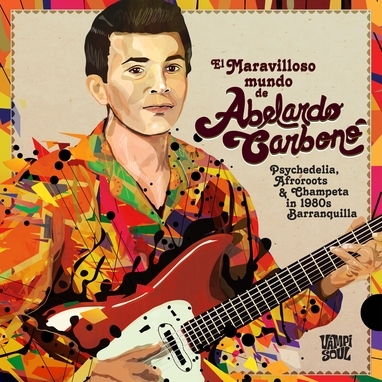Abelardo Carbonó y su Conjunto
Guana Tangula
22,00€
Vampisoul
Abelardo Carbonó y su Conjunto
Guana Tangula
Carbonó’s early work was different from his contemporaries. It was definitely not salsa, nor was it really cumbia. Rather, it was novel and genius polyglot stew of diverse musical strains with African roots but never before blended in this way. Styles like afrobeat, soukous and highlife were effortlessly stirred together with elements of the Cuban son, touches of Latin rock and funk, with a pinch of calypso, a hint of Haitian compas and even a dash of rock and roll, not to mention a foundation of local coastal Colombian varieties like vallenato and porro
This 1980 LP still sounds refreshingly unique and hip today, as if Abelardo Carbonó y su conjunto were the missing link between the 1950s pan-Caribbean acoustic guitar-led sounds of Bovea y sus Vallenatos and the more electronic and Africanized genres of champeta and terapia of more recent years. You can even hear slide guitar and psychedelic echo effects in the mix, which brings the recordings to a whole other level of the unexpected.
Presented in its original artwork and pressed on 180g vinyl.
Colombian music has its true originals, rebels and geniuses. Many have commercial pop sensibilities, good luck, and achieve stardom in their time. Others have not been so lucky and are just a little too original and outside the norm to be widely accepted or well known. Thankfully, if they were lucky enough to find a sympathetic record label, their pioneering work at least found a home. Such is the case with Abelardo Carbonó who, despite thinking ‘outside-the-box’, was able to record two brilliant albums in 1980 and ’81 for Codiscos’ imprint Costeño, as well as several other labels, his first being Africa llama under the band name Grupo Abharca for the Sonolux imprint Caliente in 1978.
Guitarist, singer, songwriter and one time policeman Abelardo Carbonó (b. 1948, Ciénaga, Magdalena) hails from Baranquilla and his early work was different from his contemporaries. It was definitely not salsa, nor was it really cumbia. Rather, it was novel and genius polyglot stew of diverse musical strains with African roots but never before blended in this way. Styles like afrobeat, soukous and highlife were effortlessly stirred together with elements of the Cuban son, touches of Latin rock and funk, with a pinch of calypso, a hint of Haitian compas and even a dash of rock and roll, not to mention a foundation of local coastal Colombian varieties like vallenato and porro. Carbonó himself has admitted that Venezuelan psychedelic afro-rock outfit Grupo Bota was a big influence as well, and his father Abelardo Sr. was a famous porro and cumbia guitarist in Los Tigrillos, which must have affected Abelardo Jr. from the beginning. You can even hear slide guitar and psychedelic echo effects in the mix, which brings the recordings to a whole other level of the unexpected.
The particular blend Carbonó and his bandmates created sounded unlike anything else at the time, and is still refreshingly unique and hip today. It’s as if Abelardo Carbonó y su conjunto were the missing link between the 1950s pan-Caribbean acoustic guitar-led sounds of Bovea y sus Vallenatos and the more electronic and Africanized genres of champeta and terapia of more recent years. Joined by the crucial nucleus of his brothers Abel on lead guitar and Jafeth on bass, Carbonó’s debut record Guana Tangula has a pleasingly easygoing, deceptively simple sound with a tropical, African vibe that features lilting acoustic guitars, pleasant but slightly odd vocals and snappy percussion (including the traditional vallenato caja drum) that would change later with the addition of amplified electric guitars, drum machines and loops.
There is a certain casual playfulness and freedom in this LP that brings to mind swaying palm trees, white beaches with turquoise waters, sunshine and romance. At the time it came out, it was a popular record. However, soon after he recorded his second disk for Codiscos, La negrera del negrerío, things changed in Colombia due to the ascendancy of the drug cartels and ‘payola’ was the name of the game, so Carbonó’s brief chance at big label mainstream popularity lost out to huge bribes by the marijuana traffickers who wanted their preferred artists to rise to the top. Thankfully his profile has been restored of late through various compilations and collaborations, which is all the sweeter because he’s still performing and recording, and this faithful reproduction of Guana Tangula should serve as a crucial part of Abelardo Carbonó’s legacy for years to come.
Productos relacionados
22,00€
Carbonó’s early work was different from his contemporaries. It was definitely not salsa, nor was it really cumbia. Rather, it was novel and genius polyglot stew of diverse musical strains with African roots but never before blended in this way. Styles like afrobeat, soukous and highlife were effortlessly stirred together with elements of the Cuban son, touches of Latin rock and funk, with a pinch of calypso, a hint of Haitian compas and even a dash of rock and roll, not to mention a foundation of local coastal Colombian varieties like vallenato and porro
This 1980 LP still sounds refreshingly unique and hip today, as if Abelardo Carbonó y su conjunto were the missing link between the 1950s pan-Caribbean acoustic guitar-led sounds of Bovea y sus Vallenatos and the more electronic and Africanized genres of champeta and terapia of more recent years. You can even hear slide guitar and psychedelic echo effects in the mix, which brings the recordings to a whole other level of the unexpected.
Presented in its original artwork and pressed on 180g vinyl.
Colombian music has its true originals, rebels and geniuses. Many have commercial pop sensibilities, good luck, and achieve stardom in their time. Others have not been so lucky and are just a little too original and outside the norm to be widely accepted or well known. Thankfully, if they were lucky enough to find a sympathetic record label, their pioneering work at least found a home. Such is the case with Abelardo Carbonó who, despite thinking ‘outside-the-box’, was able to record two brilliant albums in 1980 and ’81 for Codiscos’ imprint Costeño, as well as several other labels, his first being Africa llama under the band name Grupo Abharca for the Sonolux imprint Caliente in 1978.
Guitarist, singer, songwriter and one time policeman Abelardo Carbonó (b. 1948, Ciénaga, Magdalena) hails from Baranquilla and his early work was different from his contemporaries. It was definitely not salsa, nor was it really cumbia. Rather, it was novel and genius polyglot stew of diverse musical strains with African roots but never before blended in this way. Styles like afrobeat, soukous and highlife were effortlessly stirred together with elements of the Cuban son, touches of Latin rock and funk, with a pinch of calypso, a hint of Haitian compas and even a dash of rock and roll, not to mention a foundation of local coastal Colombian varieties like vallenato and porro. Carbonó himself has admitted that Venezuelan psychedelic afro-rock outfit Grupo Bota was a big influence as well, and his father Abelardo Sr. was a famous porro and cumbia guitarist in Los Tigrillos, which must have affected Abelardo Jr. from the beginning. You can even hear slide guitar and psychedelic echo effects in the mix, which brings the recordings to a whole other level of the unexpected.
The particular blend Carbonó and his bandmates created sounded unlike anything else at the time, and is still refreshingly unique and hip today. It’s as if Abelardo Carbonó y su conjunto were the missing link between the 1950s pan-Caribbean acoustic guitar-led sounds of Bovea y sus Vallenatos and the more electronic and Africanized genres of champeta and terapia of more recent years. Joined by the crucial nucleus of his brothers Abel on lead guitar and Jafeth on bass, Carbonó’s debut record Guana Tangula has a pleasingly easygoing, deceptively simple sound with a tropical, African vibe that features lilting acoustic guitars, pleasant but slightly odd vocals and snappy percussion (including the traditional vallenato caja drum) that would change later with the addition of amplified electric guitars, drum machines and loops.
There is a certain casual playfulness and freedom in this LP that brings to mind swaying palm trees, white beaches with turquoise waters, sunshine and romance. At the time it came out, it was a popular record. However, soon after he recorded his second disk for Codiscos, La negrera del negrerío, things changed in Colombia due to the ascendancy of the drug cartels and ‘payola’ was the name of the game, so Carbonó’s brief chance at big label mainstream popularity lost out to huge bribes by the marijuana traffickers who wanted their preferred artists to rise to the top. Thankfully his profile has been restored of late through various compilations and collaborations, which is all the sweeter because he’s still performing and recording, and this faithful reproduction of Guana Tangula should serve as a crucial part of Abelardo Carbonó’s legacy for years to come.
Productos relacionados
Guana Tangula
Carbonó’s early work was different from his contemporaries. It was definitely not salsa, nor was it really cumbia. Rather, it was novel and genius polyglot stew of diverse musical strains with African roots but never before blended in this way. Styles like afrobeat, soukous and highlife were effortlessly stirred together with elements of the Cuban son, touches of Latin rock and funk, with a pinch of calypso, a hint of Haitian compas and even a dash of rock and roll, not to mention a foundation of local coastal Colombian varieties like vallenato and porro
This 1980 LP still sounds refreshingly unique and hip today, as if Abelardo Carbonó y su conjunto were the missing link between the 1950s pan-Caribbean acoustic guitar-led sounds of Bovea y sus Vallenatos and the more electronic and Africanized genres of champeta and terapia of more recent years. You can even hear slide guitar and psychedelic echo effects in the mix, which brings the recordings to a whole other level of the unexpected.
Presented in its original artwork and pressed on 180g vinyl.
Colombian music has its true originals, rebels and geniuses. Many have commercial pop sensibilities, good luck, and achieve stardom in their time. Others have not been so lucky and are just a little too original and outside the norm to be widely accepted or well known. Thankfully, if they were lucky enough to find a sympathetic record label, their pioneering work at least found a home. Such is the case with Abelardo Carbonó who, despite thinking ‘outside-the-box’, was able to record two brilliant albums in 1980 and ’81 for Codiscos’ imprint Costeño, as well as several other labels, his first being Africa llama under the band name Grupo Abharca for the Sonolux imprint Caliente in 1978.
Guitarist, singer, songwriter and one time policeman Abelardo Carbonó (b. 1948, Ciénaga, Magdalena) hails from Baranquilla and his early work was different from his contemporaries. It was definitely not salsa, nor was it really cumbia. Rather, it was novel and genius polyglot stew of diverse musical strains with African roots but never before blended in this way. Styles like afrobeat, soukous and highlife were effortlessly stirred together with elements of the Cuban son, touches of Latin rock and funk, with a pinch of calypso, a hint of Haitian compas and even a dash of rock and roll, not to mention a foundation of local coastal Colombian varieties like vallenato and porro. Carbonó himself has admitted that Venezuelan psychedelic afro-rock outfit Grupo Bota was a big influence as well, and his father Abelardo Sr. was a famous porro and cumbia guitarist in Los Tigrillos, which must have affected Abelardo Jr. from the beginning. You can even hear slide guitar and psychedelic echo effects in the mix, which brings the recordings to a whole other level of the unexpected.
The particular blend Carbonó and his bandmates created sounded unlike anything else at the time, and is still refreshingly unique and hip today. It’s as if Abelardo Carbonó y su conjunto were the missing link between the 1950s pan-Caribbean acoustic guitar-led sounds of Bovea y sus Vallenatos and the more electronic and Africanized genres of champeta and terapia of more recent years. Joined by the crucial nucleus of his brothers Abel on lead guitar and Jafeth on bass, Carbonó’s debut record Guana Tangula has a pleasingly easygoing, deceptively simple sound with a tropical, African vibe that features lilting acoustic guitars, pleasant but slightly odd vocals and snappy percussion (including the traditional vallenato caja drum) that would change later with the addition of amplified electric guitars, drum machines and loops.
There is a certain casual playfulness and freedom in this LP that brings to mind swaying palm trees, white beaches with turquoise waters, sunshine and romance. At the time it came out, it was a popular record. However, soon after he recorded his second disk for Codiscos, La negrera del negrerío, things changed in Colombia due to the ascendancy of the drug cartels and ‘payola’ was the name of the game, so Carbonó’s brief chance at big label mainstream popularity lost out to huge bribes by the marijuana traffickers who wanted their preferred artists to rise to the top. Thankfully his profile has been restored of late through various compilations and collaborations, which is all the sweeter because he’s still performing and recording, and this faithful reproduction of Guana Tangula should serve as a crucial part of Abelardo Carbonó’s legacy for years to come.
Carbonó’s early work was different from his contemporaries. It was definitely not salsa, nor was it really cumbia. Rather, it was novel and genius polyglot stew of diverse musical strains with African roots but never before blended in this way. Styles like afrobeat, soukous and highlife were effortlessly stirred together with elements of the Cuban son, touches of Latin rock and funk, with a pinch of calypso, a hint of Haitian compas and even a dash of rock and roll, not to mention a foundation of local coastal Colombian varieties like vallenato and porro
This 1980 LP still sounds refreshingly unique and hip today, as if Abelardo Carbonó y su conjunto were the missing link between the 1950s pan-Caribbean acoustic guitar-led sounds of Bovea y sus Vallenatos and the more electronic and Africanized genres of champeta and terapia of more recent years. You can even hear slide guitar and psychedelic echo effects in the mix, which brings the recordings to a whole other level of the unexpected.
Presented in its original artwork and pressed on 180g vinyl.
Colombian music has its true originals, rebels and geniuses. Many have commercial pop sensibilities, good luck, and achieve stardom in their time. Others have not been so lucky and are just a little too original and outside the norm to be widely accepted or well known. Thankfully, if they were lucky enough to find a sympathetic record label, their pioneering work at least found a home. Such is the case with Abelardo Carbonó who, despite thinking ‘outside-the-box’, was able to record two brilliant albums in 1980 and ’81 for Codiscos’ imprint Costeño, as well as several other labels, his first being Africa llama under the band name Grupo Abharca for the Sonolux imprint Caliente in 1978.
Guitarist, singer, songwriter and one time policeman Abelardo Carbonó (b. 1948, Ciénaga, Magdalena) hails from Baranquilla and his early work was different from his contemporaries. It was definitely not salsa, nor was it really cumbia. Rather, it was novel and genius polyglot stew of diverse musical strains with African roots but never before blended in this way. Styles like afrobeat, soukous and highlife were effortlessly stirred together with elements of the Cuban son, touches of Latin rock and funk, with a pinch of calypso, a hint of Haitian compas and even a dash of rock and roll, not to mention a foundation of local coastal Colombian varieties like vallenato and porro. Carbonó himself has admitted that Venezuelan psychedelic afro-rock outfit Grupo Bota was a big influence as well, and his father Abelardo Sr. was a famous porro and cumbia guitarist in Los Tigrillos, which must have affected Abelardo Jr. from the beginning. You can even hear slide guitar and psychedelic echo effects in the mix, which brings the recordings to a whole other level of the unexpected.
The particular blend Carbonó and his bandmates created sounded unlike anything else at the time, and is still refreshingly unique and hip today. It’s as if Abelardo Carbonó y su conjunto were the missing link between the 1950s pan-Caribbean acoustic guitar-led sounds of Bovea y sus Vallenatos and the more electronic and Africanized genres of champeta and terapia of more recent years. Joined by the crucial nucleus of his brothers Abel on lead guitar and Jafeth on bass, Carbonó’s debut record Guana Tangula has a pleasingly easygoing, deceptively simple sound with a tropical, African vibe that features lilting acoustic guitars, pleasant but slightly odd vocals and snappy percussion (including the traditional vallenato caja drum) that would change later with the addition of amplified electric guitars, drum machines and loops.
There is a certain casual playfulness and freedom in this LP that brings to mind swaying palm trees, white beaches with turquoise waters, sunshine and romance. At the time it came out, it was a popular record. However, soon after he recorded his second disk for Codiscos, La negrera del negrerío, things changed in Colombia due to the ascendancy of the drug cartels and ‘payola’ was the name of the game, so Carbonó’s brief chance at big label mainstream popularity lost out to huge bribes by the marijuana traffickers who wanted their preferred artists to rise to the top. Thankfully his profile has been restored of late through various compilations and collaborations, which is all the sweeter because he’s still performing and recording, and this faithful reproduction of Guana Tangula should serve as a crucial part of Abelardo Carbonó’s legacy for years to come.




